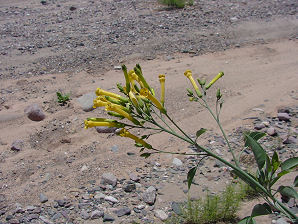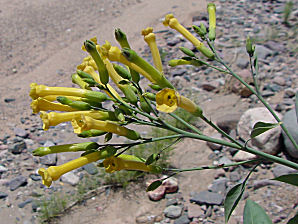Arizona Wild Flowers
Pictures, Photos, Images
Descriptions, Information, Reviews.
Tree Tobacco, Nicotiana glauca.
We Are Proud Of Our SafeSurf Rating!
Click On Any Of The Following Links By Amazon.Com
For Books, & Videos About Wildflowers Of Arizona & The Southwest USA. No Obligation!
 |
| Tree Tobacco, Nicotiana glauca |
|---|
 |  |
| Tree Tobacco, Nicotiana glauca | Tree Tobacco, Nicotiana glauca |
|---|---|
 | |
| Tree Tobacco, Nicotiana glauca | Tree Tobacco, Nicotiana glauca |
Tree Tobacco.
We wish to thank Wikipedia, the free encyclopedia for some of the information on this page. We share images and information with Wikipedia. Nicotiana glauca is an annual, biannual, or sometimes a short-lived perennial shrub or tree. It stands up to 25 feet in height. Large plants have numerous multi-branched stems arising from their bases. The large leaves are oblong, green, and clasp the stem. They become smaller as they near the end of the branches� flowering top. The small, tubular, cream-colored, greenish white flowers form at branch ends. The seed capsules contain many small brown seeds. The entire plant is sticky and covered with small hairs. It is commonly found in Arizona and parts of New Mexico. Look for this native plant in disturbed soils, vacant lots, trail and roadsides, flood plains, and along washes and drainages. The oval to lance-shaped leaves are up to 7 inches long and covered with soft, short hairs. They grow opposite each other on the stem, attached directly at the base. The five-lobed, yellowish, trumpet-shaped flowers are about 1.5 to 3 inches long. The flowers are hermaphrodite (have both male and female organs) and are pollinated by Lepidoptera (Moths & Butterflies). Tree tobacco, while related to tobacco, is said not to contain nicotine. Instead, Nicotiana glauca's active ingredient is anabasine--an alkaloid similar to nicotine. Parts of this plant are considered poisonous.
Quick Notes:
Height: From 2 - 10 Feet Tall.
Flowers: The yellow flowers are 1 � inches long by � inches wide. The flower has a long, tubular 5-lobed greenish-yellow corolla only slightly flared at the apex and a 5-cleft, unequally-toothed calyx.
Flowering Time: Mid March - November.
Seeds & Seed Pods: he seed capsules contain many small brown seeds.
Leaves: Leaves simple, smooth-edged, spade-shaped to 7" long. They are alternate, entire, ovate to ovate-lanceolate on long petioles.
Found: Throughout Arizona and New Mexico. It is native to South Bolivia and North Argentina.
Hardiness:
Soil pH requirements:
Sun Exposure:
Elevation: 0 - 4,000 Feet.
Habitat: Found in gravelly-sandy washes and river edges.
Miscellaneous: Flowering Photos Taken May 1, 2003. In Castle Creek, Arizona.
|
We Are Proud Of Our SafeSurf Rating!
Click On Any Of The Following Links By Amazon.Com
For Books, & Videos About Wildlife Of Arizona & The Southwest USA. No Obligation!
| © 1966 - Present, Audrey, Eve, & George DeLange |
